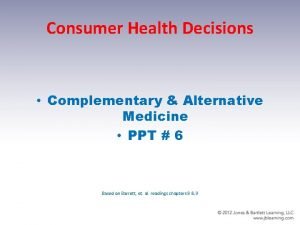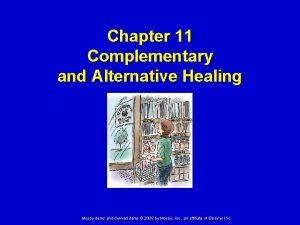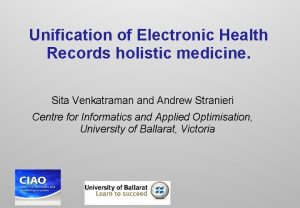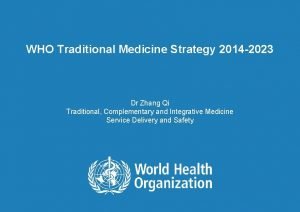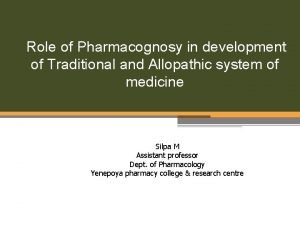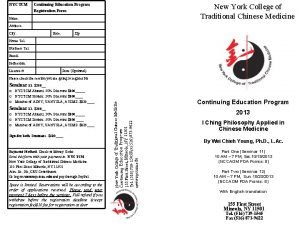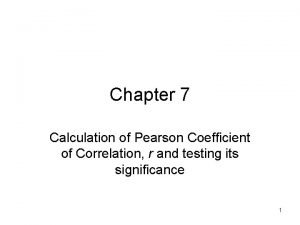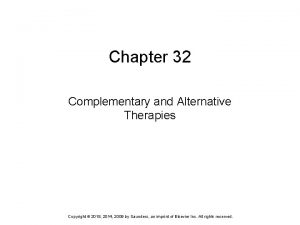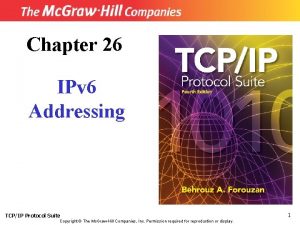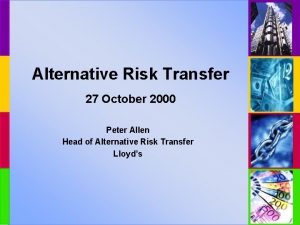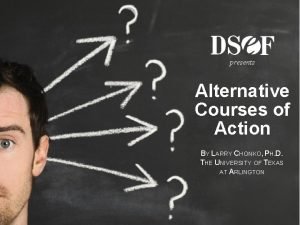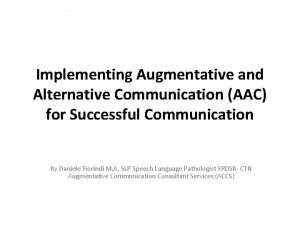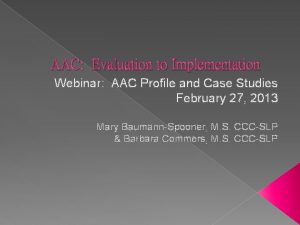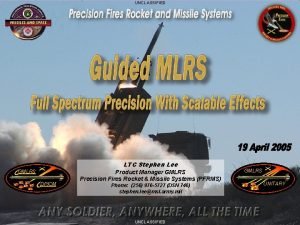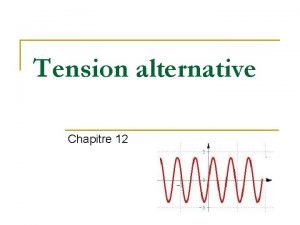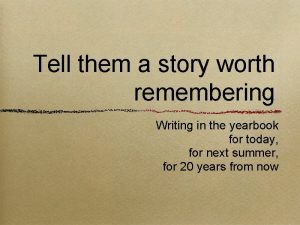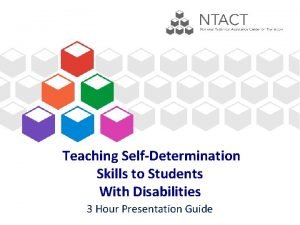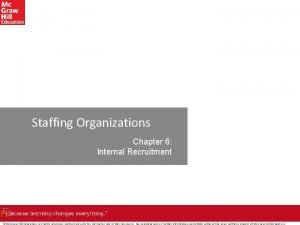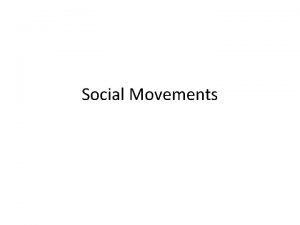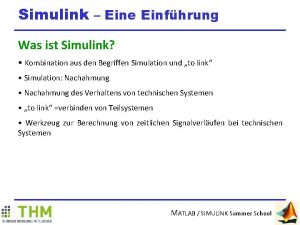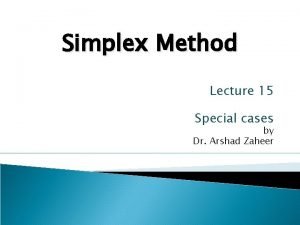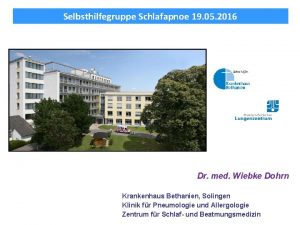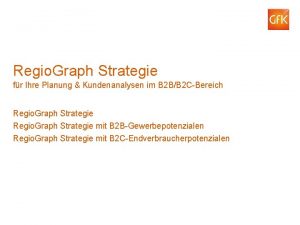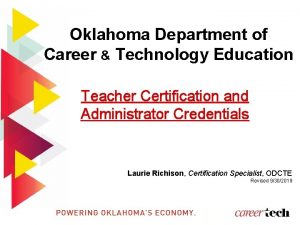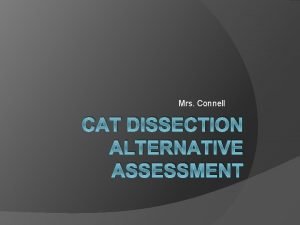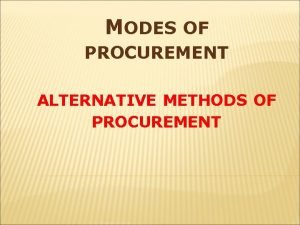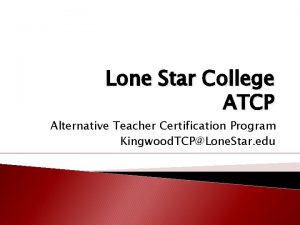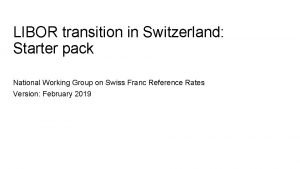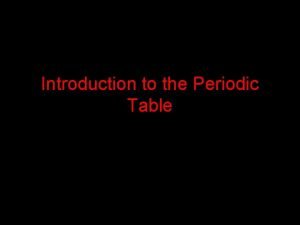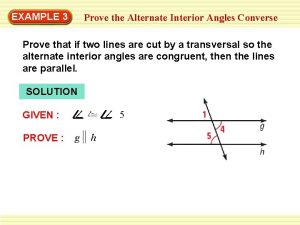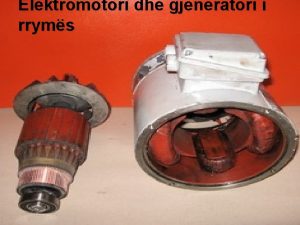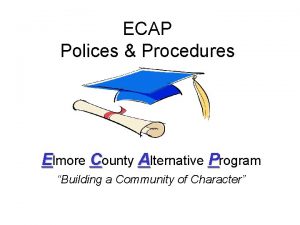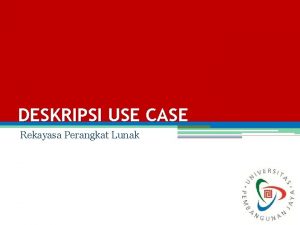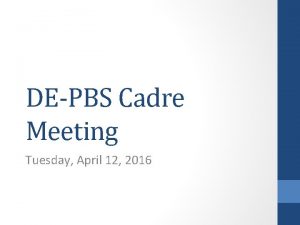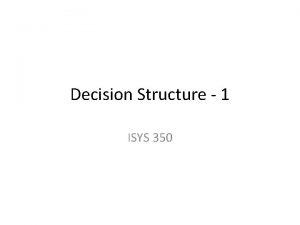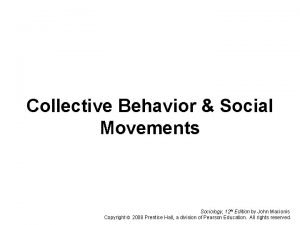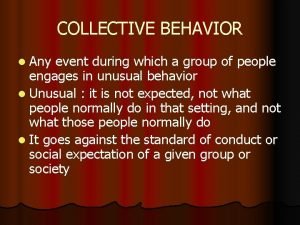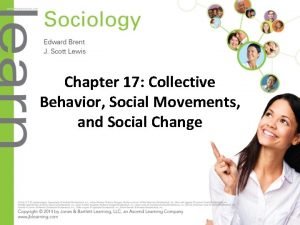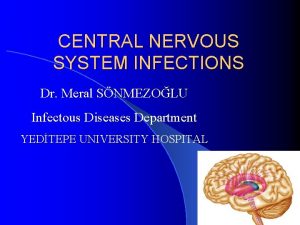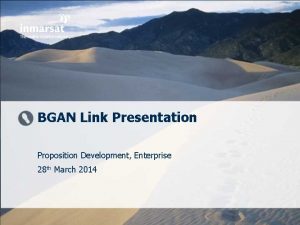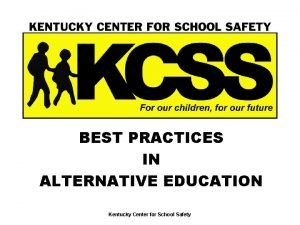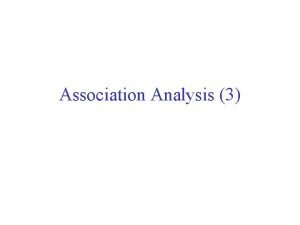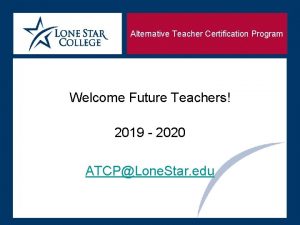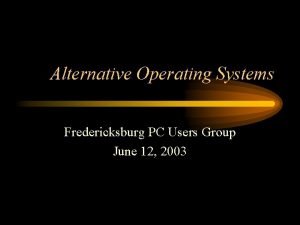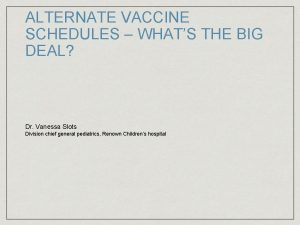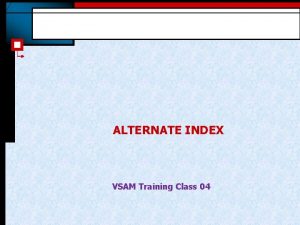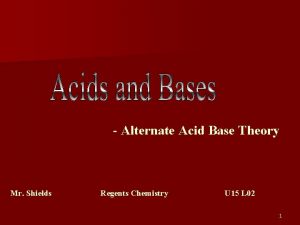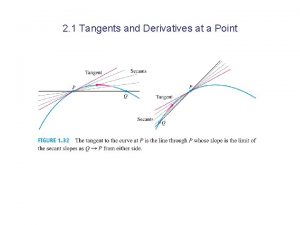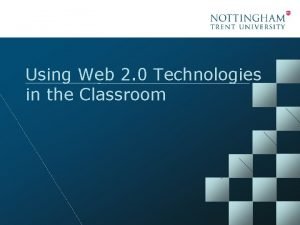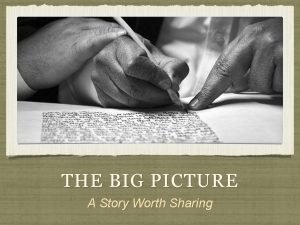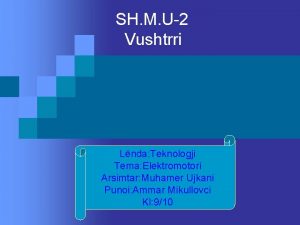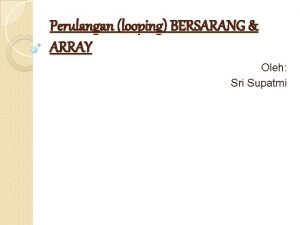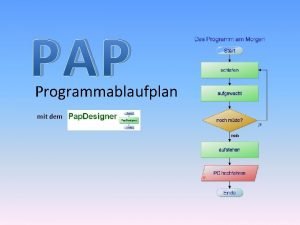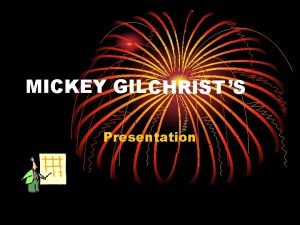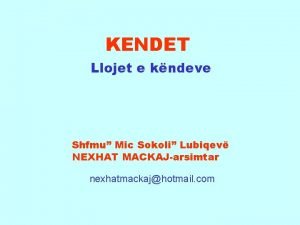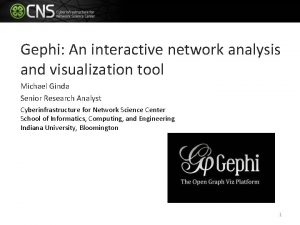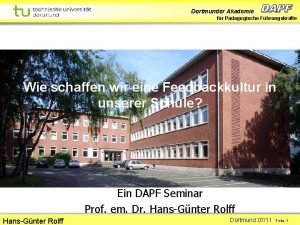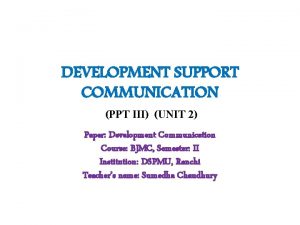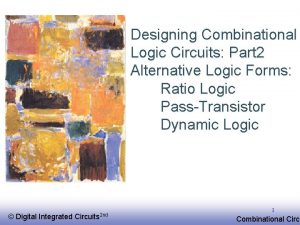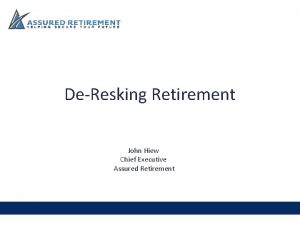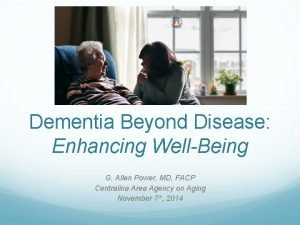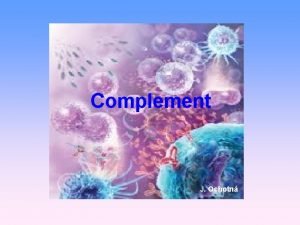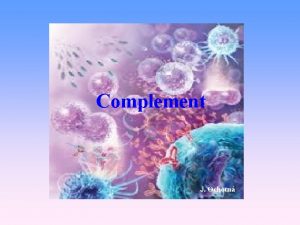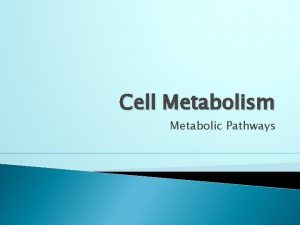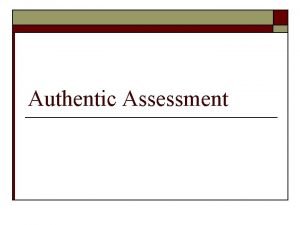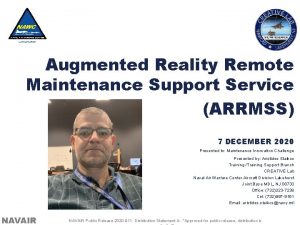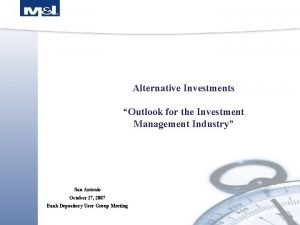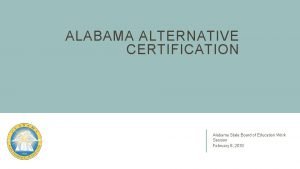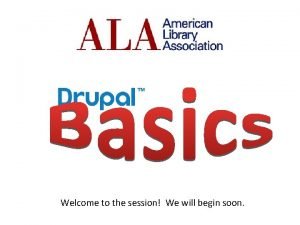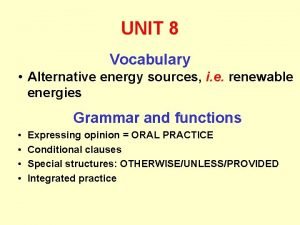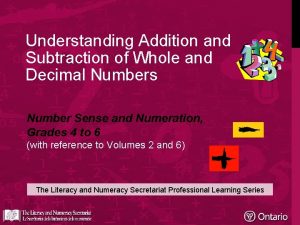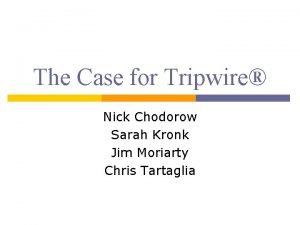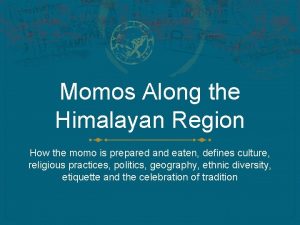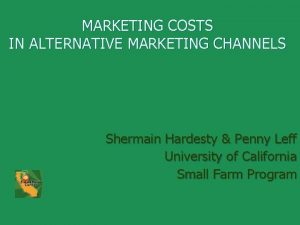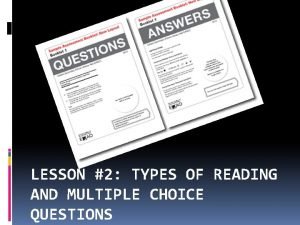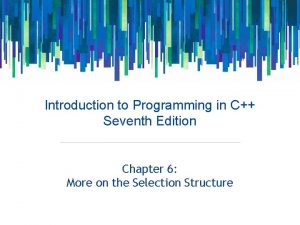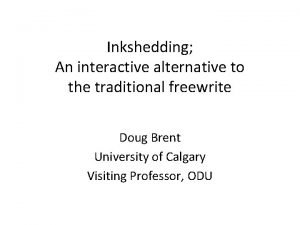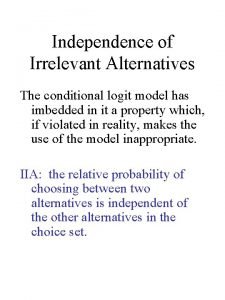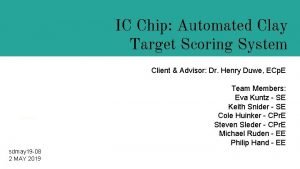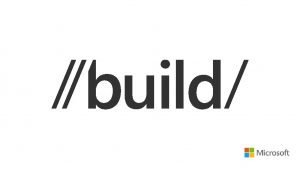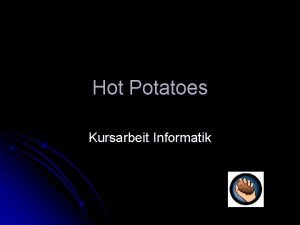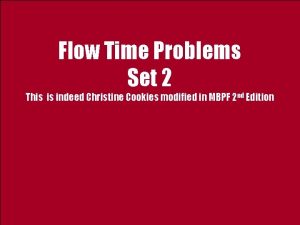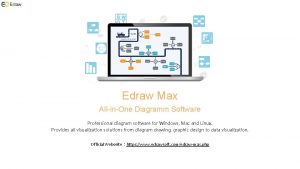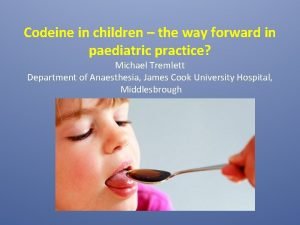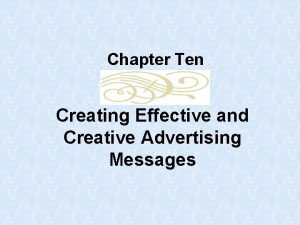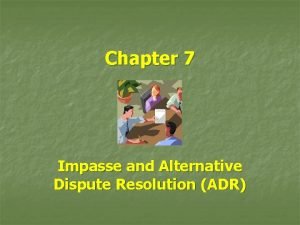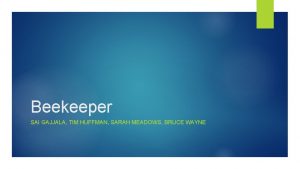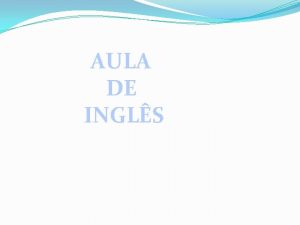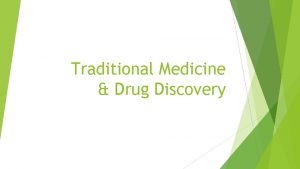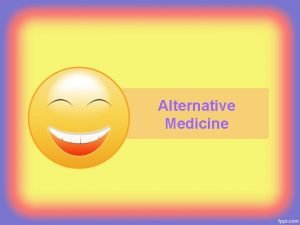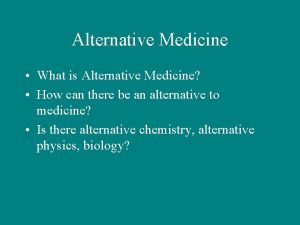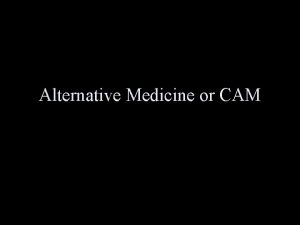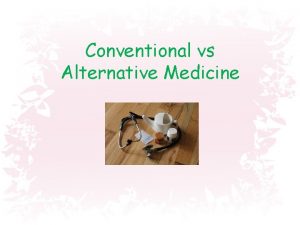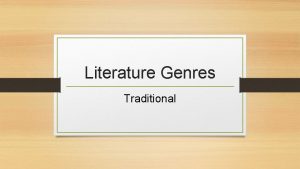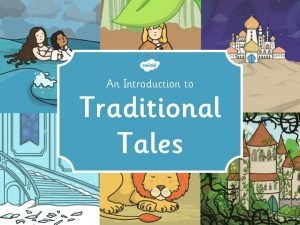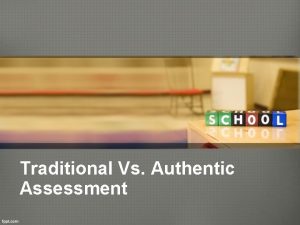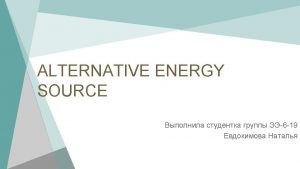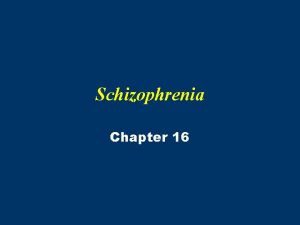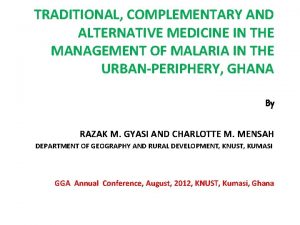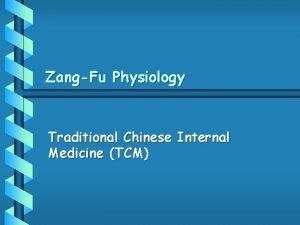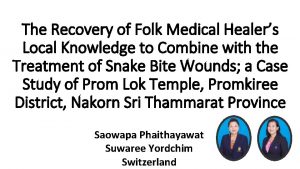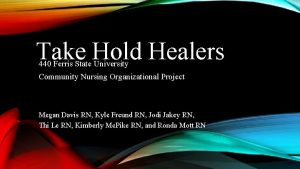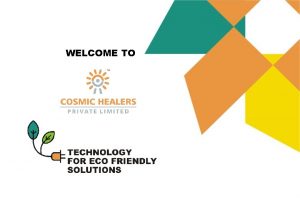ALTERNATIVE MEDICINE AND TRADITIONAL HEALERS DR O T






















































































































- Slides: 118

ALTERNATIVE MEDICINE AND TRADITIONAL HEALERS DR O. T AWOTUNDE DEPT. OF FAMILY MEDICINE

Why learn about alternative medical systems • Alternative medical systems are widely patronized worldwide and the patronage is increasing. • In Africa, traditional medicine serves up to 80% of the people at the primary health care level.

Why learn about alternative medical systems • Our commitment to the patient is ‘from cradle to grave‘ • The patient’s attitude and practice with regard to alternative medicine influences his utilization of conventional health services. • Knowledge of alternative medicine will help us serve our patients well in terms of counseling them on its merits and dangers.

HISTORICAL BACKGROUND • Before the late 18 th century, medicine was largely unregulated with different medical systems practising side by side. • In the late 18 th and 19 th century, regular and irregular practitioners became more clearly differentiated in Europe. • As the 19 th century progressed, most Western states converged in the creation of legally delimited and semi-protected medical markets.

HISTORICAL BACKGROUND • It was at this point that science based medicine became the ‘official’ medicine recognized by the state. • With the rapid advances in the medical sciences of the late 19 th century onwards, scientific medicine became the mainstreams medical system.

HISTORICAL BACKGROUND • From the 1970 s, medical professionals and other commentators noted the increasing visibility of health practices that had neither derived directly from nor been verified by biomedical science. • These practices were termed heterodox, irregular, fringe and alternative medicine or quackery. • The most persistent term has been alternative medicine but its use is problematic.

Definitions • Alternative medicine - a group of diverse medical and health care systems, practices, and products that are not generally considered part of conventional medicine (US NCCAM). • Complementary medicine is alternative medicine used together with conventional medical treatment in a belief that it "complements" the treatment. • CAM – Complementary and alternative medicine

Understand some Definitions • “Complementary Medicine is Used Together With Conventional Medicine. ” • “Alternative Medicine is Used in Place of Conventional Medicine. ”

Integrative Medicine • is healing-oriented medicine that takes account of the whole person (body, mind, and spirit), including all aspects of lifestyle. It emphasizes therapeutic relationship and makes use of all appropriate therapies, both conventional and alternative.

• Integrative Medicine "combines mainstream medical therapies and CAM therapies for which there is some high-quality scientific evidence of safety and effectiveness. "

Introduction • Alternative medicine includes any healing practice that does not fall within the realm of conventional medicine. • Alternative medicine practices differ in their fundamental principles and methodologies

TYPES OF COMPLEMENTARY AND ALTERNATIVE PRACTICES


1. Whole Medical Systems

Homeopathic medicine

• Homeopathy is based on the belief that a disease can be cured by a very low dose of a substance that creates similar symptoms in a healthy person • These treatments often worsened symptoms and sometimes proved fatal.

Scientific Appraisal • Numerous clinical trials have been conducted on homeopathic remedies. • Most show no effect beyond placebo while some remedies could actually be harmful

Naturopathic Medicine

The Principles • Naturopathic medicine, is based on a belief in vitalism, which states that a vital force guides bodily processes such as metabolism, reproduction, growth, and adaptation. • Naturopathy favors a holistic approach to health care with non-invasive treatment and minimal use of surgery and drugs. • It is principally practiced in US and Canada.

• Naturopathy is difficult to evaluate because of the wide range of treatment modalities • The principle of vitalism on which it is based lacks scientific evidence. • scientific evidence does not support claims that naturopathic medicine can cure any disease. • Virtually no studies on naturopathy as a whole have been published

Ayurvedic medicine

Historical background • Ayurvedic medicine is a system of traditional medicine which was developed in the Indian subcontinent. • Over centuries the practitioners developed medicinal preparations and surgical procedures for the treatment of various ailments. • These were compiled in the traditional encyclopedia of medicine

Underlying principles/practice • Ayurvedic theory tends to emphasise that building a healthy metabolic system, attaining good digestion, and proper excretion lead to vitality. • Ayurveda also focuses on exercise, yoga, meditation and diet

Scientific appraisal • Many ayurveda products have not been tested in rigorous scientific studies and clinical trials. • A review of ayurveda and cardiovascular disease concluded that the evidence for ayurveda was not convincing, though some herbs seemed promising.

Traditional Chinese medicine

Traditional Chinese Medicine • Traditional Chinese medicine is a broad range of medicine practices sharing common concepts which have been developed in China and are based on a tradition of more than 5, 000 years.

Traditional Chinese Medicine • It includes various forms of herbal medicine, acupuncture, massage (Tui na), exercise (qigong), and dietary therapy. • It’s model of the body, or concept of disease, are not supported by modern evidence-based medicine

Model of the body • The body is seen to be composed of fuctional entities rather than organs and organ systems. • Qi (a functional entity that runs through the body) • Xue (blood circulation) • Jinye (body fluids • Zang fu (organ functions) • Jing-luo (Meridians)

Disease concept • Disease is perceived as a disharmony (or imbalance) in the functions or interactions of yin, yang, qi, xuĕ, zàng-fǔ, meridians etc. and/or of the interaction between the human body and the environment. • Therapy is based on which "pattern of disharmony" can be identified • Symptoms combinations are used to recognize pattern of disharmony

EXAMPLES OF TRADITIONAL CHINESE MEDICINE

Acupuncture • Acupuncture means insertion of needles into superficial structures of the body (skin, subcutaneous tissue, muscles) – usually at acupuncture points – and their subsequent manipulation • This aims at influencing the flow of qi. • According to TCM it relieves pain and treats (and prevents) various diseases

Acupuncture According to WHO acupuncture may have an effect on: • adverse reactions to chemotherapy and radiation, • induction of labor, • sciatica, • dysmenorrhea, • depression, • hypertension, • rheumatoid arthritis, and • low back pain.

Tui na • Tui na is a form of massage akin to acupressure. Oriental massage is typically administered with the patient fully clothed, without the application of grease or oils.

Qigong • Qìgōng is a TCM system of exercise and meditation that combines regulated breathing, slow movement, and focused awareness, purportedly to cultivate and balance qi. • One branch of qigong is qigong massage, in which the practitioner combines massage techniques with awareness of the acupuncture channels and points

Traditional African medicine

Traditional African Medicine • This is a holistic discipline involving indigenous herbalism and African spirituality, typically involving diviners, midwives, and herbalists. • Claims are made for the cure of various conditions such as cancers, psychiatric disorders, high blood pressure, venereal diseases, epilepsy, asthma, eczema, fever etc • A large proportion of African population depends on Traditional African medicine.

• There is increased interest in this form of practice in Africa due to poor access to conventional medicine as well as its high cost. • The diagnoses and chosen methods of treatment are based of sociocultural believes and rely heavily on spiritual aspects.

Traditional Healers • Traditional healers are practitioners of traditional African medicine. • They fulfill different social and political roles in the community, including divination, healing physical, emotional and spiritual illnesses, directing birth or death rituals, finding lost cattle, protecting warriors, counteracting witches, and narrating the history, cosmology, and myths of their tradition.

Traditional Healers • Traditional healers are often the first and last line of defence against the most contagious and debilitating diseases that plague lives. • Although Western medicine is generally accepted throughout Africa, it has not replaced but rather augmented indigenous health approaches.

Traditional healer from Johannesburg,

Traditional Healers • healers, for the most part, are not officially recognized by governments. • They operate outside formal health structures. But leaving traditional healers on the sidelines can have serious consequences. • Some patients, preferring the healers, may disregard their doctor’s advice or take herbal medicines that could have dangerous interactions with pharmaceuticals.

Traditional Healers • The gulf between modern and traditional practitioners has narrowed somewhat in the past decade. • WHO advocates incorporating safe and effective traditional medicine into primary health-care systems.

Underlying principles and practice • In African culture, it is believed that "nobody becomes sick without sufficient reason. " • The search is not for ‘what’ causes the disease but ‘who’ • Diseases are believed to stem from a lack of balance between the patient and his or her social environment or the spiritual world, not by natural causes.

Underlying principles and practice • Sickness is often attributed to guilt by the person, family, or village for a sin or moral infringement. • The illness, therefore, would stem from the displeasure of the gods or God, due to an infraction of universal moral law. • Incantations are sometimes used for diagnosis and treatment.

Underlying principles and practice • Incantations are used to achieve mystical and cosmic connections • Divination is used if the illness is not easily identified to be able to know the diagnosis and line of treatment. a diviner who can further give a diagnosis and cure. • Treatment may require not only medication but sacrifices as well.

Underlying principles and practice • Treatments ranges from "magic" to biomedical methods such as fasting and dieting, herbal therapies, bathing, massage, and surgical procedures

Protective waist charm

Scientific Appraisal • While the spiritual aspects of Traditional African medicine has no scientific basis, medicinals are already been studied and some of them are promising. • These hopefully will be integrated into modern medicine when proven to be efficacious.

2. Manipulative and Body- based Practices

Manipulative Body Based • Manipulative and body-based practices deal with the structure and systems of the body. • They include: • ➢Chiropractic Practices • ➢Massage • ➢ Osteopathy • ➢Pilates

Chiropractic • How does it work? ➢Chiropractic treatment involves manipulation of the spine. • It is used to treat musculoskeletal problems (muscles, joints, bones, and connective tissue), and • alleviate muscle tension or pain in the shoulder, neck and back caused by stress.

Chiropractic Research • ➢Chiropractic is most often used to treat musculoskeletal conditions - problems with the muscles, joints, bones, and connective tissue such as cartilage, ligaments, and tendons. • ➢Research has shown it to be an effective short-term treatment for low back pain.

Chiropractic Risk ➢Chiropractic treatment for some types of pain is controversial. ➢There is risk of complications with manipulation of the neck ➢ Practitioners are required to be licensed to practice.

MASSAGE How does it work? ➢Massage is the manipulation of skin, muscles and joints (usually by hand) to relax muscle spasms, relieve tension, and improve circulation. ➢ It also stretches connective tissue and improves circulation. Various techniques include: Femoral Massage, Myofascial Release.

Massage Research Some report benefits of massage include: ➢Reduced anxiety and depression ➢Improved alertness ➢Relief from insomnia ➢Improved blood circulation ➢Reduced muscle tension ➢Improved digestive function ➢Relief from pain ➢Improved immune function

Osteopathy • It involves treatment of medical disorders through manipulation and massage of the skeleton • It emphasizes manual adjustments, myofascial release and other manipulation of muscle tissue, joint and bone. • Osteopathy is based on the principle that the well -being of an individual depends on their bones, muscles, ligaments and connective tissue functioning together.

Pilates • This is a physical fitness system, called “Contrology” • It has not been shown to be an effective treatment for any medical condition • It puts emphasis on alignment, breathing, developing a strong core and improving balance and coordination.

3. Biologically Based Practice

Biologically Based Practices • Biologically-based CAM practices use substances that people can eat or drink. Including: ➢HERBS ➢VITAMINS, ➢ MINERALS ➢ & DIETARY SUPPLEMENTS • It also includes ➢DIET BASED THERAPY ➢FOLK MEDICINE

Herbal medicine • Herbal medical practice is the most popular form of alternative medicine. • Herbal medicine is seen as the use of herbs to treat sickness or the use of herbs for their therapeutic and medicinal values.

Herbal medicine • This makes use of plant materials, minerals, animal substances and human body parts • Effectiveness of these remedies remains poorly documented.

Herbal Medicine • Although Western medical practices seem to have questioned or even denied the efficacy of herbal remedies, traditional plants undoubtedly continue to play a key role in the well-being of indigenous communities which abound in the West African region

Herbal Medicine • Africa is endowed with many plants that can be used for medicinal purposes. • Out of the approximated 6400 plant species used in tropical Africa, more than 4000 are used as medicinal plants

Herbal medicine • Many drugs used in conventional medicine were originally derived from plants • Salicylic acid is a precursor of aspirin that was originally derived from white willow bark • Quinine and Artemesinin are antimalarial drugs derived from Cinchona pubescens bark and Artemisia annua plant respectively. • Morphine and codeine are derived from the poppy plant • Digitalis is a cardiac glycoside derived from foxglove plant

• ARTEMISININ PLANT FROM • CINCHONA TREE WHICH ARTESUNATE WAS FROM WHICH DERIVED QUININE WAS DERIVED

• POPPY PLANT FROM WHICH MORPHINE WAS DERIVED • FOXGLOVE PLANT FROM WHICH DIGOXIN WAS DERIVED

Herbal medicine • It is estimated that one quarter of all medical prescriptions are based on plant derivatives or plant-derived synthetic derivatives. • WHO estimates that 80% of the population of some Asian and African countries presently use herbal medicine for some aspect of primary health care.

Herbal medicines include: • herbs, • herbal materials, • herbal preparations • finished herbal products that contain parts of plants as active ingredients.

Preparing and drying out freshly dug traditional medicines

Herbal Medicine • Herbal remedies come in a variety of different forms: herbal baths, capsules, compresses, douches, extracts, implants, oils, plasters, salves, teas, infusions, ointments, concoctions and wraps. • Clearly, herbal medicine has become a booming industry as well as a therapeutic healing technique

Herbs Research • ➢Several herbs have been shown to have positive effects on osteoarthritis, migraine, back pain, and neuropathic pain. • ➢Although herbs are increasingly popular, minimal research has been done with herbs in the field of pain management and the results are mixed.

Herbs • Herbs are not regulated or tested, and no safety determination has been made about these substances prior to marketing. • It is very important to check for the potential of bad interactions when taking herbs while taking medications.

Diet Based therapy • A number of conditions are treated in part with therapeutic diets • Treatment includes foods that improve specific health conditions • Therapeutic diets may limit nutrients such as salt to control blood pressure or saturated fat to manage hypercholesterolaemia.

Folk Medicine • This is medicine practiced based on traditional beliefs within various societies. • This developed before the era of modern medicine. • Magic and witchcraft played a major role. • Also involved plant-derived remedies on an empirical basis.

4. Mind-body Medicine

MIND-BODY MEDICINE Mind-body medicine looks at how the mind and the body work together: the powerful ways that feelings, thoughts, friendships, spiritual beliefs, and behaviors can directly affect health. These include: ➢Biofeedback ➢Cognitive behavior therapy ➢Hypnosis ➢Meditation ➢Tai Chi ➢Visual Imagery ➢Yoga

Biofeedback How does it work? ➢This technique uses sensitive instruments, like electrical sensors, to measure, amplify, and provide feedback on physiological responses, such as muscle tension, pulse rate, and body temperature, related to stress. ➢Biofeedback teaches you to regulate these physiological processes through relaxation.

Biofeedback Research • ➢Studies are looking at biofeedback for headache, migraine, and back pain. • ➢Biofeedback has been found effective in treating anxiety, hypertension, headache, muscle tension, migraines, and insomnia. • ➢Studies have shown that the majority of people with panic and anxiety disorders who underwent biofeedback saw improvement.

BIOFEEDBACK HEALTH RISK • Biofeedback poses no direct health risks • treatment can be with an experienced professional trained in this technique

Cognitive Behavioral Therapy How does it work? • ➢Cognitive behavioral techniques (CBT) are used to help people change self-defeating and irrational patterns of thought, to plan ahead, and to better problem solve. • ➢Cognitive restructuring teaches one to examine negative thought patterns, evaluate the truth of these thoughts, and, if they are not true, correct them.

Cognitive Behavioral Therapy Research CBT has been shown to: • ➢Address psychological components of pain: feelings, coping skills and sense of control • ➢Reduce pain and disability • ➢Decrease headaches and medication use • ➢Reduce stress-related physical and emotional symptoms • ➢Increase understanding of one's own and other people's behavior

Cognitive Behavioral Therapy ➢Clinical psychologists, psychiatric nurses, and social workers are the primary practitioners of these techniques.

Hypnosis How does it work? • Hypnosis is a suggestion technique that alters one's state of consciousness by concentrating on an object, image, or task. All other stimuli are blocked out. • The goal is to create a natural, relaxed state of extreme focus and attention, in which the human mind can most easily accept suggestion that may improve an aspect of one's life, including physical health.

Hypnosis Research ➢The National Institutes of Health has endorsed the use of hypnosis in combination with conventional medical care in a variety of chronic pain conditions: • ❖Chronic migraines • ❖Hypertension • ❖Immune problems • ❖Ulcers • ❖Anxiety and depression ➢While research on the benefits of hypnosis is extensive, it is difficult to generalize results to other medical conditions.

Meditation How does it work? • ➢Meditation is a conscious mental process using techniques such as focusing attention or maintaining a specific posture, in order to suspend the stream of thought and relax the body.

Meditation Research • ➢Meditation can produce physiologic changes that may reduce the body’s inflammatory response mechanism • ➢Studies have shown that meditation helps relieve anxiety and depression. • ➢Meditation may be used to reduce muscle tension, stress, anxiety, insomnia, high blood pressure, and some types of chronic pain. • ➢Increasingly, pain management clinics are incorporating meditation into their patient services.

Tai Chi How does it work? ➢Tai Chi is sometimes called “moving meditation. ” People using Tai Chi move their bodies slowly and gently, and with awareness, while breathing deeply.

Tai Chi Research suggests ➢Scientific research is ongoing. ➢ Studies have focused on the elderly using Tai Chi as a way to prevent falls and improve cardiovascular fitness and overall well-being. ➢Tai Chi has been studied to see if it enhances the immune system and lowers blood pressure.

Tai Chi Health Risk • Tai Chi is relatively safe. • As with any exercise, overdoing can cause sore muscles.

Visual imagery How does it work? • ➢Visual imagery, also called guided imagery, uses the imagination to create vivid images that the body can perceive and respond to. • This technique can ease stress and increase relaxation.

Visual imagery Research suggests • ➢Visual imagery can produce physiologic changes that may reduce the body’s inflammatory response mechanism. • ➢Visual imagery has been frequently used to help people receiving chemotherapy for cancer, dialysis for kidney failure, and other treatments that can be experienced as uncomfortable or painful. • ➢Increasingly, mental health providers and nurses in pain management clinics are incorporating visual imagery into their patient services

Yoga How does it work? ➢There are many different styles of yoga, originating in India. ➢ Typically yoga styles combine physical postures, breathing techniques and meditation.

Yoga Research The National Institutes of Health is currently studying the benefits of yoga in a number of clinical trials. Research suggests that yoga might: • ❖Improve mood and sense of well-being • ❖Counteract stress • ❖Positively affect levels of certain brain or blood chemicals

Yoga Safety • Yoga is one of the top 10 CAM modalities used in the U. S. • It is generally considered safe

5. Energy Medicine

Energy Medicine These include: ➢ACUPUNCTURE ➢HEALING TOUCH ➢QI GONG ➢REIKI

Acupuncture How does it work? • ➢This ancient Chinese practice in which needles are inserted near pressure points associated with certain nerves may play a role in some health issues, including chronic pain. • ➢ According to traditional Chinese medicine acupuncture improves the flow of qi (“chee”), or energy, throughout the body. The actual process is not fully understood.

Acupuncture Research suggests • ➢A few studies, with limited samples, suggest acupuncture alone or with complementary therapies is associated with improvement in severity of chronic pain. • ➢Acupuncture when migraine symptoms first begin may be as effective as other leading treatments. • ➢Acupuncture may reduce stress, depression, and anxiety.

Acupuncture Safety • ➢Negative effects are relatively uncommon, but may include slight pricks and/or skin irritation, or in very rare cases punctured organs if not delivered properly. • ➢Acupuncture should be only one part of the comprehensive medical treatment.

Healing touch How does it work? • ➢Healing touch, sometimes called therapeutic touch may be a light physical touch or sweeping hand motion over the body. • ➢ It’s goal is for the practitioner to use their own energy to identify the patient’s energy imbalance, and to correct this imbalance to promote health.

Healing touch Research suggests ➢Some practitioners of healing touch may touch the body, but most do not, since they are working with the body’s energy fields. ➢There is no evidence that healing touch has a positive effect on chronic pain. ➢ There are no known risks with healing touch. ➢The use of healing touch is the subject of ongoing research.

Qi Gong How does it work? • ➢Qi Gong is a component of traditional Chinese medicine that combines movement, meditation, and controlled breathing, with the goals of improving blood flow and energy flow

Qi Gong Research suggests ➢Qi Gong is largely unproven or experimental. ➢There is no evidence to suggest that Qi Gong has a positive effect on chronic pain. ➢ There are no known risks with Qi Gong. ➢There is ongoing research being done on its use.

Reiki How does it work? • ➢Reiki practitioners seek to transmit universal energy to the patient. They do this from a distance, or from placing their hands on or near the person. Their goal is to heal the spirit which in turn will heal the body.

Reiki Research suggests • ➢Some reiki practitioners may touch the body but most do not. • ➢Reiki is largely unproven. • ➢There is no evidence to suggest that Reiki has a positive effect on chronic pain. ➢There are no known risks with Reiki, and research into its usefulness is ongoing.

Challenges of CAM

CHALLENGES OF CAM • • Lack of funding for research. Lack of regulatory bodies Standardization Unknown side effect

Determinants of CAM Use

Determinants of CAM Use The common determinants of CAM use include: • socio- demographic characteristics of patients • complex psycho-social and cultural factors • Patients may choose to use CAM because they are dissatisfied with conventional treatments that are perceived to be ineffective or have unpleasant side effects • Patients may also find CAM attractive because it is consonant with their personal values, religious and health philosophies.

Determinants of CAM Use • As the orthodox medical facilities co-exists with traditional medicine systems in many regions of Africa and elsewhere, people may use medicine from one system exclusively or they may acquire medicine from each health system and use it simultaneously or sequentially. • In Nigeria, multiple channels of care utilized and range across traditional healers, spiritual churches, and pharmacies

CAM AND FAMILY PHYSICIANS

CAM AND FAMILY PHYSICIANS • Build rapport and show patient respect. • Be non judgmental despite your personal opinion • Understand that CAM can be beneficial when used correctly • Be aware that CAM can be dangerous if it interacts with conventional treatment.

CAM AND FAMILY PHYSICIANS • Educate the public about the positive and negative information regarding CAM • Be aware that the use of CAM is popular and increasing and must be included as part of the history • The family physician should be able to fulfill the role of patient advocate by reciprocal open communication

CAM AND FAMILY PHYSICIAN • Facilitating patient informed choice • avoiding harmful or useless practice • help in implementing an integrated care plan

CONCLUSION • There is no doubt that modern medicine is far from meeting the demands of patients for optimal methods of prevention, treatment and cure of diseases • We are far from achieving cure for most chronic non communicable diseases. • Some of our methods of treatment are not socially and culturally acceptable to our clients.

CONCLUSION • These factors will continue to drive them to seek alternative care irrespective of whether such methods are effective or not. • Our clients also believe that conventional medical practice is ignorant of the healing potentials of alternative medicine. • We must not disregard these practices rather we must educate and continuously update ourselves on their merits and demerits.

CONCLUSION • There can be no doubt that some of the alternative methods will prove, after testing, to be safe and effective. • Modern medicine should continue to be open to the testing of selected unconventional treatments. • In keeping an open mind, however, we must not lose our commitment to rational thought and the rule of evidence.

Non Drug Therapies for Pain -2013 118
 Alternative and complementary therapies ppt
Alternative and complementary therapies ppt Chapter 11 complementary and alternative medicine
Chapter 11 complementary and alternative medicine Holistic medicine ehr
Holistic medicine ehr Who traditional medicine strategy 2014–23
Who traditional medicine strategy 2014–23 Madar kabab chini tagar are the examples of
Madar kabab chini tagar are the examples of Ny college of traditional chinese medicine
Ny college of traditional chinese medicine Indigenous color wheel
Indigenous color wheel Hybrid and alternative fuel vehicles
Hybrid and alternative fuel vehicles Developing null and alternative hypothesis
Developing null and alternative hypothesis Ssxx formula
Ssxx formula Chapter 32 complementary and alternative therapies
Chapter 32 complementary and alternative therapies Null and alternative hypothesis statistics
Null and alternative hypothesis statistics An address with 128 alternative 1s and 0s
An address with 128 alternative 1s and 0s Advantages and disadvantages of alternative risk transfer
Advantages and disadvantages of alternative risk transfer Larry chonko
Larry chonko Aac aids
Aac aids Augmentative and alternative communication profile
Augmentative and alternative communication profile Planning alternative tomorrows with hope
Planning alternative tomorrows with hope Veyon manual
Veyon manual Gmlrs alternative warhead
Gmlrs alternative warhead Générateur de tension alternative
Générateur de tension alternative Storyworth alternative
Storyworth alternative Planning alternative tomorrows with hope
Planning alternative tomorrows with hope Cover uncover test vs alternating cover test
Cover uncover test vs alternating cover test Chartwell staffing jobs
Chartwell staffing jobs Social movement
Social movement Simulink alternative
Simulink alternative Unbounded solution in simplex method example
Unbounded solution in simplex method example Wiebke dohrn
Wiebke dohrn Green energy concept
Green energy concept Regiograph alternative
Regiograph alternative Promoting alternative thinking strategies
Promoting alternative thinking strategies Oklahoma department of career and technology education
Oklahoma department of career and technology education West virginia alternative teacher certification
West virginia alternative teacher certification Dissection alternative assignment
Dissection alternative assignment Alternative procurement
Alternative procurement Lone star college teacher certification
Lone star college teacher certification Swiss nwg
Swiss nwg Periodic table by stowe and tarantola
Periodic table by stowe and tarantola Alternative marketing
Alternative marketing Lincoln street alternative high school
Lincoln street alternative high school Alternate interior angle converse
Alternate interior angle converse Rryma alternative dhe gjeneratori
Rryma alternative dhe gjeneratori Ecap school
Ecap school Alternative flow use case
Alternative flow use case Planning alternative tomorrows with hope
Planning alternative tomorrows with hope Single alternative decision structure
Single alternative decision structure Enduring service intensifiers examples
Enduring service intensifiers examples What is a social movement sociology
What is a social movement sociology Alternative social movement
Alternative social movement Alternative programming languages
Alternative programming languages Types of social movement
Types of social movement Ventriculitis
Ventriculitis Alternative forms of business organization
Alternative forms of business organization Bgan alternative
Bgan alternative Education uky
Education uky Permeability
Permeability Axigen alternative
Axigen alternative Alternative methods for generating frequent itemsets
Alternative methods for generating frequent itemsets Dhh operator certification
Dhh operator certification Alternative operating systems
Alternative operating systems Dr sears delayed vaccine schedule 2021
Dr sears delayed vaccine schedule 2021 Alternative index in vsam
Alternative index in vsam Alternate acid theory
Alternate acid theory Example of derivative
Example of derivative Underline the correct alternative:
Underline the correct alternative: Piratepad alternative
Piratepad alternative Picture says a thousand words
Picture says a thousand words Motori i rrymes alternative
Motori i rrymes alternative Nested for loop alternative
Nested for loop alternative Schleife pap
Schleife pap Nn gilchrist
Nn gilchrist Solar portable alternative communications energy system
Solar portable alternative communications energy system Lp´l
Lp´l Kendet suplementare
Kendet suplementare Winlink domestic
Winlink domestic Gephi alternative
Gephi alternative Spickmich alternative
Spickmich alternative Participatory communication ppt
Participatory communication ppt Alternative logic gates
Alternative logic gates John hiew
John hiew Eden alternative domains of wellbeing
Eden alternative domains of wellbeing How to write an alternative ending to a story
How to write an alternative ending to a story Alternative complement pathway
Alternative complement pathway Basophil markers
Basophil markers Alternative metabolic pathways
Alternative metabolic pathways Rocks cluster distribution
Rocks cluster distribution ........ is an alternative of log based recovery.
........ is an alternative of log based recovery. Authentic task meaning
Authentic task meaning Remote maintenance augmented reality
Remote maintenance augmented reality Hris excel
Hris excel Alternative investment outlook
Alternative investment outlook Alternative certification alabama
Alternative certification alabama Pu foam making formula
Pu foam making formula Define channel design
Define channel design Navpod alternative
Navpod alternative Alternative energy vocabulary
Alternative energy vocabulary Alternative algorithms for subtraction
Alternative algorithms for subtraction Nick chodorow
Nick chodorow Solihull alternative provision academy
Solihull alternative provision academy Prey project alternative
Prey project alternative Khinkali alternative names
Khinkali alternative names Alternative marketing channels
Alternative marketing channels Donns hair alternative
Donns hair alternative Juvenile justice alternative education program
Juvenile justice alternative education program Multiple alternative selection structure
Multiple alternative selection structure Inkshedding
Inkshedding Independence of irrelevant alternatives example
Independence of irrelevant alternatives example Claytargetscoring
Claytargetscoring Bginfo alternative
Bginfo alternative Jcloze
Jcloze Mckinsey 9 box matrix
Mckinsey 9 box matrix Flor control doz
Flor control doz Edraw max online
Edraw max online Feminax ultra alternative
Feminax ultra alternative Resonance creative style advertising example
Resonance creative style advertising example Skill7 alternative
Skill7 alternative Redeapp alternative
Redeapp alternative Mark the right alternative about “quantifiers
Mark the right alternative about “quantifiers
